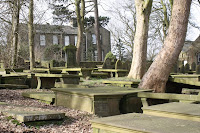From following this blog so far, one might get the impression that we're on an extended holiday here in York. Nothing could be farther from the truth. Kate and I are teaching two courses, one on British culture (with an emphasis on literature, history, and current events), and one on British Church history, from the beginnings through the Reformation. And most of our Wednesdays and Saturdays, we have organized excursions for our group of twenty Calvin students, to show them the places we have discussed in class. Here are a few group pictures I took on two of those excursions: in Lindisfarne on the left, and Rievaulx Abbey on the right. We have a group of students we can be really proud of, and the enthusiasm they show for this semester is heart-warming.
 No one today would ever guess that peaceful and rural Rosedale, in the North York Moors, was once the site of an iron mining industry, belching out thick smoke over the moors. Trains were running from Rosedale over Blakey Junction to Ingleby’s Incline, where the carts were hauled down a steep tramway, and transported further to Newcastle and the North. The mines were closed in the 1920s, and today, nothing remains of this industrial past but ruins (visible in the centre of the photo), and the former railroad bed, now used as a footpath all along Rosedale. (Images from Rosedale's railroading past at http://web.onyxnet.co.uk/Auffret-onyxnet.co.uk/railways/gall_frame.htm)
No one today would ever guess that peaceful and rural Rosedale, in the North York Moors, was once the site of an iron mining industry, belching out thick smoke over the moors. Trains were running from Rosedale over Blakey Junction to Ingleby’s Incline, where the carts were hauled down a steep tramway, and transported further to Newcastle and the North. The mines were closed in the 1920s, and today, nothing remains of this industrial past but ruins (visible in the centre of the photo), and the former railroad bed, now used as a footpath all along Rosedale. (Images from Rosedale's railroading past at http://web.onyxnet.co.uk/Auffret-onyxnet.co.uk/railways/gall_frame.htm) With a group of students, we took the bus to see the Daffodils bloom in Farndale (a popular outing in the Spring for many locals), and from there we hiked over Blakey Ridge, to Rosedale. The daffodils were not yet at their peak (one can hardly imagine the crowd here when they are!), but the walk along the River Dove was very pleasant. But the spectacular part was hiking over the high moors to Rosedale, and back over Sherriff’s Pit, also the site of a former iron mine. There were some spectacular views of Rosedale along the way (pictures below).
With a group of students, we took the bus to see the Daffodils bloom in Farndale (a popular outing in the Spring for many locals), and from there we hiked over Blakey Ridge, to Rosedale. The daffodils were not yet at their peak (one can hardly imagine the crowd here when they are!), but the walk along the River Dove was very pleasant. But the spectacular part was hiking over the high moors to Rosedale, and back over Sherriff’s Pit, also the site of a former iron mine. There were some spectacular views of Rosedale along the way (pictures below). 












